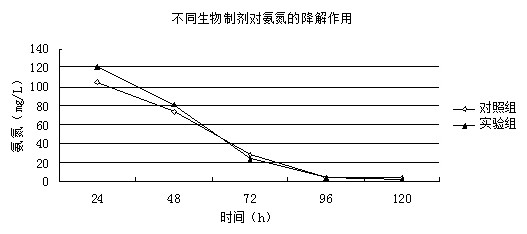A method for recycling fermentation bacteria and treating waste water
A technology for fermenting bacteria and collecting bacteria, which is applied in chemical instruments and methods, neutralized water/sewage treatment, aerobic and anaerobic process treatment, etc. Low added value and other issues to achieve the effect of avoiding excessive proliferation, simple process and high porosity
- Summary
- Abstract
- Description
- Claims
- Application Information
AI Technical Summary
Problems solved by technology
Method used
Image
Examples
Embodiment 1
[0037] A biological agent for treating waste water from a xanthan gum fermentation process, which is prepared according to the following process:
[0038] Mix kaolin and bentonite according to the mass ratio of 2:1, and then add them to a ball mill equipped with ball milling media (5mm silicon carbide balls, mass ratio of material balls: 1:5) for ball milling for 30min, dry at 80°C for 15min, and then pass 100 Mesh sieve to collect undersize;
[0039] Mix polyvinyl alcohol, attapulgite, urea, water, and undersieve according to the mass ratio of 3:5:7:70:100, and then put them into a granulator for granulation to obtain wet granules with a diameter of 1mm , then placed in 80 ℃ drying for 30 minutes, then placed in a resistance furnace for calcination at 1000 ℃ for 30 minutes, after natural cooling, ceramsite was obtained;
[0040] Mix bacterial agent A and ceramsite according to the ratio of 1L:2kg, and culture at 30°C for 6h.
[0041] Then add bacterial agent B, 40g / L sodium...
Embodiment 2
[0046] A biological agent for treating waste water from a xanthan gum fermentation process, which is prepared according to the following process:
[0047] Mix kaolin and bentonite according to the mass ratio of 2:1, and then add them to a ball mill equipped with ball milling media (5mm silicon carbide balls, mass ratio of material balls: 1:5) for ball milling for 30min, dry at 80°C for 15min, and then pass 100 Mesh sieve to collect undersize;
[0048] Mix polyvinyl alcohol, attapulgite, urea, water, and undersize according to the mass ratio of 3:5:7:70:100, and then put them into a granulator for granulation to obtain wet granules with a diameter of 2mm , then placed in 80 ℃ drying for 30 minutes, then placed in a resistance furnace for calcination at 1000 ℃ for 40 minutes, after natural cooling, ceramsite was obtained;
[0049] Mix bacterial agent A and ceramsite according to the ratio of 1L:2kg, and culture at 30°C for 6h.
[0050] Then add bacteria agent B, 50g / L sodium a...
Embodiment 3
[0056] Index detection of ceramsite in the present invention.
[0057] Porosity: use the boiling method of GB / T1966-1996 to measure the porosity of the sample;
[0058] Mechanical strength: measured by GBT1965 / 1996 test method for bending strength of porous ceramics.
[0059] The specific indicators are shown in Table 1:
[0060] Table 1
[0061] group Porosity% Mechanical Strength Mpa Density g / ml Example 1 72.8 14.6 1.04 Example 2 70.6 15.3 1.08
[0062] It can be seen that the porosity of the ceramsite carrier of the present invention reaches more than 70%, the pore diameter is between 0.1-10 microns, it is easy to process, the strength is high, the porosity is high, the density is close to water, it is in a suspended state, and the dispersion in waste water is good , which is conducive to the rapid adsorption and treatment of pollutants.
PUM
| Property | Measurement | Unit |
|---|---|---|
| pore size | aaaaa | aaaaa |
| porosity | aaaaa | aaaaa |
Abstract
Description
Claims
Application Information
 Login to View More
Login to View More - R&D
- Intellectual Property
- Life Sciences
- Materials
- Tech Scout
- Unparalleled Data Quality
- Higher Quality Content
- 60% Fewer Hallucinations
Browse by: Latest US Patents, China's latest patents, Technical Efficacy Thesaurus, Application Domain, Technology Topic, Popular Technical Reports.
© 2025 PatSnap. All rights reserved.Legal|Privacy policy|Modern Slavery Act Transparency Statement|Sitemap|About US| Contact US: help@patsnap.com


